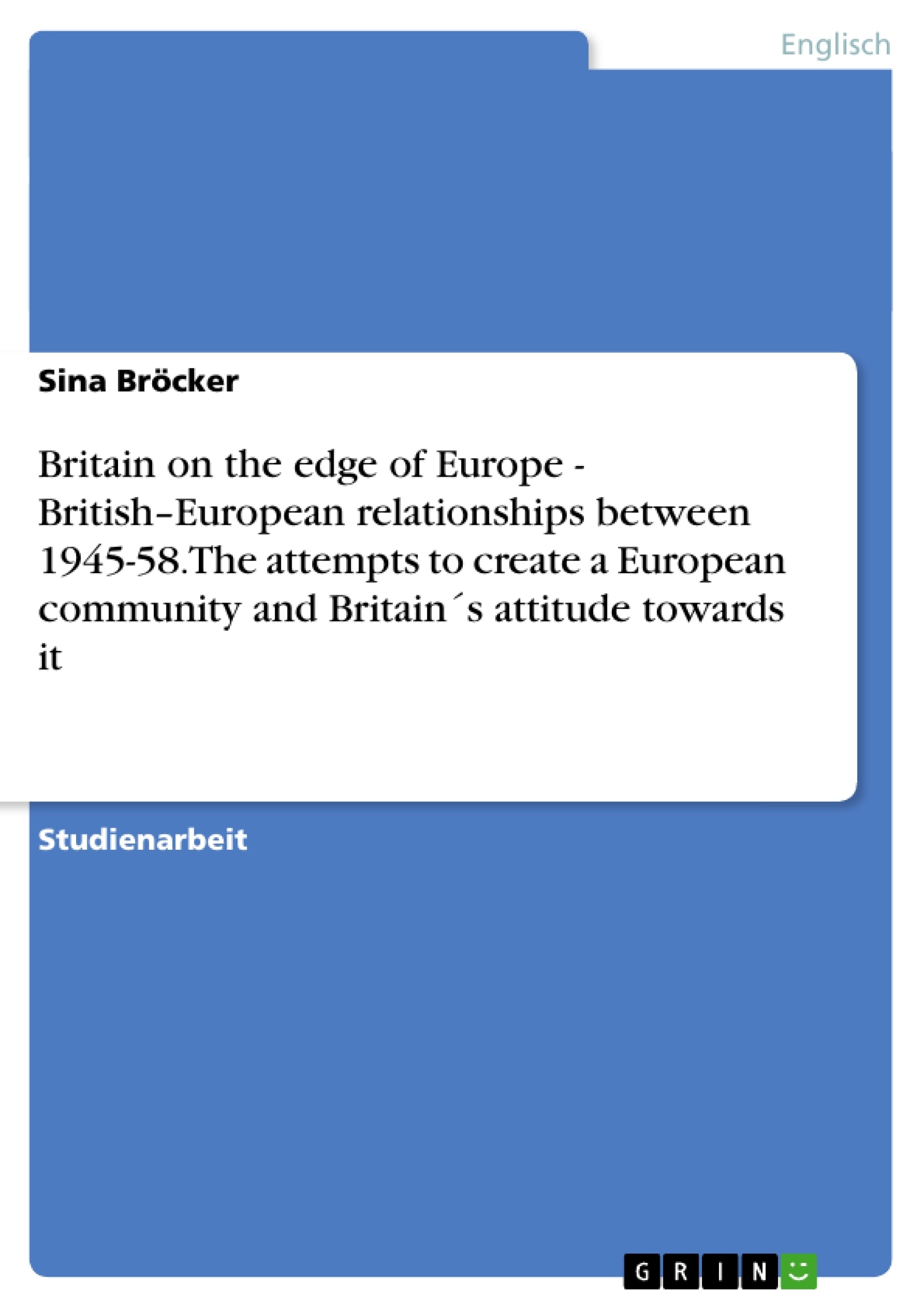Never before it seemed so necessary for European countries to demonstrate strong company than after World War II. Some countries immediately started to meet and talk about what could be done to prevent Europe for wars like the one that just ended. The idea of forming a federation with one government as head was not new. Even in earlier stages in history countries tried to unify Europe. At that time the means of reaching the aim were invasion and elimination. The war led by Hitler was the last attempt to reach uniformity by force. The smaller European countries started to talk about integration and about forming a customers union as a first step.
Great Britain, still a leading power in world trade and politics, did not feel as a part of Europe. Politics after World War II to 1958 were mainly dominated by the relationship between Great Britain and continental Europe. Mainly the Six wanted an integration of Western Europe. Britain did not feel comfortable with the idea of being part of a union and did not want to join the other states. They did not cooperate; contrariwise, they worked against the efforts of the other states. Great Britain jammed the attempts to form close mergers, so the formation of the European Economic Community and the concept of a common market was hard to get through by the other European countries. The aim of this paper is to give an overview about the processes of forming economic and political institutions and the attitude of Great Britain to the Continent between 1945 and 1958. The attempt is made to give reasons for Britain’s attitude and its decision against a common market. The most important events during this period will be researched and evaluated. However, this is just an approach; it is not possible to give any detailed aspects why Britain and the Continent could not work together.
Inhaltsverzeichnis
- Introduction
- 1. Great Britain and Europe between 1945 – 1955.
- 1.1 Great Britain's attitude towards Europe in the Post-war period
- 1.2 The concept of 'Three Circles'.
- 1.3 The Schuman Plan
- 2. Great Britain and the Six, 1955-58.
- 2.1 The Messina talks.
- 2.2 The MAC-report on the Question about pro and cons of joining the community
- 2.3 Economic arguments.
- 2.4 Political arguments.
- 2.5 'Plan G' and its failure.
- 3. Franco-British relationships.
- 4. Britain isolated – analysis of their decisions.
Zielsetzung und Themenschwerpunkte
Diese Arbeit befasst sich mit der Entwicklung der Beziehungen zwischen Großbritannien und dem Kontinentaleuropa im Zeitraum von 1945 bis 1958. Sie untersucht die Bemühungen um die Gründung einer Europäischen Gemeinschaft und die Haltung Großbritanniens gegenüber diesem Projekt. Ziel ist es, die Gründe für die ablehnende Haltung Großbritanniens gegenüber einer Wirtschafts- und politischen Integration Europas zu beleuchten und die wichtigsten Ereignisse dieser Zeit zu analysieren.
- Die Rolle Großbritanniens in der Nachkriegszeit und die anfängliche Skepsis gegenüber europäischer Integration
- Die "Drei-Kreise-Politik" als Ausdruck der britischen Sonderrolle und ihr Einfluss auf die europäischen Beziehungen
- Die Verhandlungen zur Gründung der Europäischen Wirtschaftsgemeinschaft und die britische Haltung gegenüber den "Sechs" (Frankreich, Italien, Belgien, Niederlande, Luxemburg und die Bundesrepublik Deutschland)
- Die Bedeutung ökonomischer und politischer Argumente für die britische Entscheidung gegen den Beitritt zur Europäischen Wirtschaftsgemeinschaft
- Die Bedeutung der Beziehungen zwischen Großbritannien und Frankreich für die Entwicklung der europäischen Integration
Zusammenfassung der Kapitel
Das erste Kapitel befasst sich mit der britischen Haltung gegenüber Europa in der Nachkriegszeit. Es wird gezeigt, dass Großbritannien zunächst wenig Interesse an einer engeren Zusammenarbeit mit den europäischen Staaten hatte und stattdessen seine Beziehungen zum Commonwealth und den Vereinigten Staaten priorisierte. Das Konzept der "Drei-Kreise-Politik", das die besondere Rolle Großbritanniens in der Welt hervorhob, wird ebenfalls analysiert.
Das zweite Kapitel behandelt die Verhandlungen zur Gründung der Europäischen Wirtschaftsgemeinschaft in den Jahren 1955 bis 1958. Es werden die wichtigsten Punkte der Messina-Gespräche und der MAC-Bericht, der die Vor- und Nachteile eines Beitritts zur Gemeinschaft untersuchte, beleuchtet. Die Kapitel analysieren auch die ökonomischen und politischen Argumente, die für oder gegen einen Beitritt Großbritanniens zur Europäischen Wirtschaftsgemeinschaft sprachen. Die Kapitel schließen mit der Analyse des "Plan G" und seinen Scheitern ab.
Das dritte Kapitel analysiert die Beziehungen zwischen Frankreich und Großbritannien, die für die Entwicklung der europäischen Integration entscheidend waren.
Das vierte Kapitel beschäftigt sich mit der Isolation Großbritanniens und analysiert die Gründe für die britischen Entscheidungen.
Schlüsselwörter
Die Arbeit konzentriert sich auf die Beziehungen zwischen Großbritannien und dem Kontinentaleuropa, die Rolle der Europäischen Wirtschaftsgemeinschaft (EWG), die "Drei-Kreise-Politik", die Schuman-Plan, die Messina-Gespräche, die MAC-Bericht, ökonomische und politische Argumente, Franco-Britische Beziehungen, Isolation Großbritanniens.
- Citation du texte
- Sina Bröcker (Auteur), 2003, Britain on the edge of Europe - British–European relationships between 1945-58. The attempts to create a European community and Britain´s attitude towards it, Munich, GRIN Verlag, https://www.grin.com/document/46670



